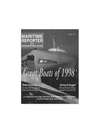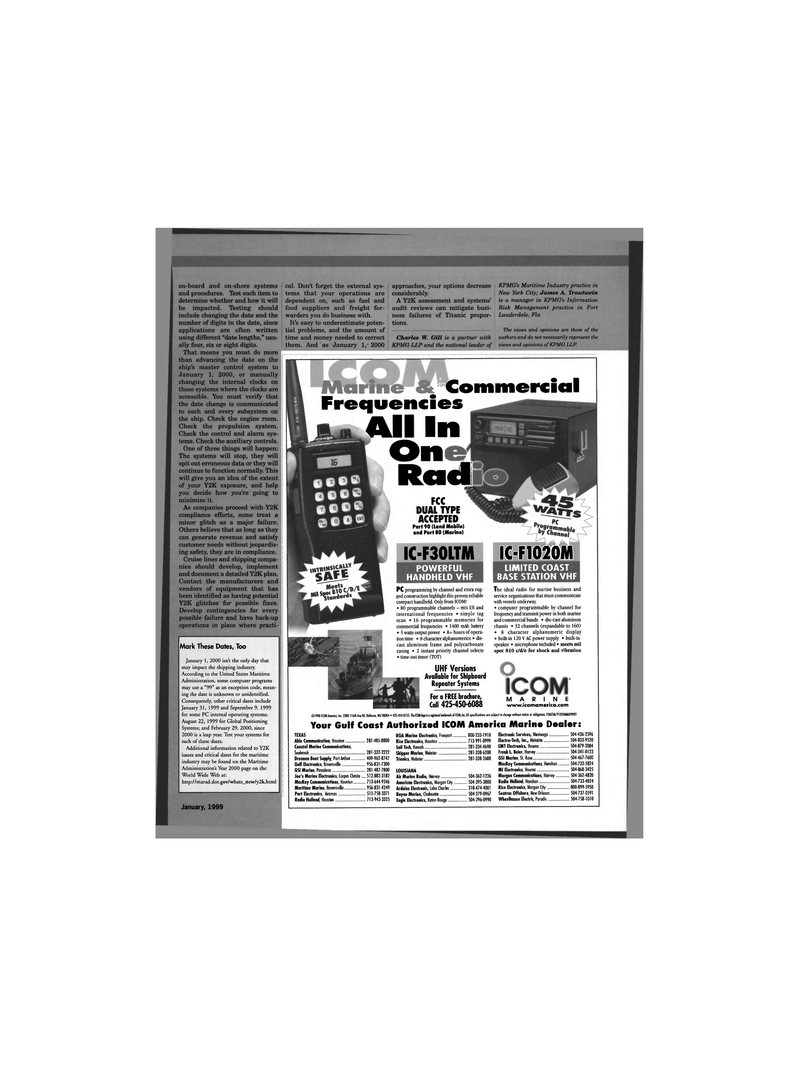
Page 25: of Maritime Reporter Magazine (January 1999)
Read this page in Pdf, Flash or Html5 edition of January 1999 Maritime Reporter Magazine
oil-board and on-shore systems and procedures. Test each item to determine whether and how it will be impacted. Testing should include changing the date and the number of digits in the date, since applications are often written using different "date lengths," usu- ally four, six or eight digits.
That means you must do more than advancing the date on the ship's master control system to
January 1, 2000, or manually changing the internal clocks on those systems where the clocks are accessible. You must verify that the date change is communicated to each and every subsystem on the ship. Check the engine room.
Check the propulsion system.
Check the control and alarm sys- tems. Check the auxiliary controls.
One of three things will happen:
The systems will stop, they will spit out erroneous data or they will continue to function normally. This will give you an idea of the extent of your Y2K exposure, and help you decide how you're going to minimize it.
As companies proceed with Y2K compliance efforts, some treat a minor glitch as a major failure.
Others believe that as long as they can generate revenue and satisfy customer needs without jeopardiz- ing safety, they are in compliance.
Cruise lines and shipping compa- nies should develop, implement and document a detailed Y2K plan.
Contact the manufacturers and vendors of equipment that has been identified as having potential
Y2K glitches for possible fixes.
Develop contingencies for every possible failure and have back-up operations in place where practi-
Mark These Dates, Too
January 1, 2000 isn't the only day that may impact the shipping industry.
According to the United States Maritime
Administration, some computer programs may use a "99" as an exception code, mean- ing the date is unknown or unidentified.
Consequently, other critical dates include
January 31, 1999 and September 9, 1999 for some PC internal operating systems;
August 22, 1999 for Global Positioning
Systems; and February 29, 2000, since 2000 is a leap year. Test your systems for each of these dates.
Additional information related to Y2K issues and critical dates for the maritime industry may be found on the Maritime
Administration's Year 2000 page on the
World Wide Web at: http://marad.dot.gov/whats_new/y2k.html
January, 1999 19 cal. Don't forget the external sys- tems that your operations are dependent on, such as fuel and food suppliers and freight for- warders you do business with.
It's easy to underestimate poten- tial problems, and the amount of time and money needed to correct them. And as January 1, 2000 approaches, your options decrease considerably.
A Y2K assessment and systems' audit reviews can mitigate busi- ness failures of Titanic propor- tions.
Charles W. Gill is a partner with
KPMG LLP and the national leader of
KPMG's Maritime Industry practice in
New York City; James A. Trautwein is a manager in KPMG's Information
Risk Management practice in Fort
Lauderdale, Fla.
The views and opinions are those of the authors and do not necessarily represent the views and opinions of KPMG LLP. m Commercial Frequencies
All In On
Rod
FCC
DUAL TYPE
ACCEPTED
Part 90 (Land Mobile) and Part 80 (Marine) 1 IC-F30LTM 1
POWERFUL HANDHELD VHF
PC programming by channel and extra rug- ged construction highlight this proven reliable compact handheld. Only from ICOM! • 80 programmable channels - mix US and international frequencies • simple tag scan • 16 programmable memories for commercial frequencies • 1400 mAh battery • 5 watts output power • 8+hours of opera- tion time • 8 character alphanumerics • die- cast aluminum frame and polycarbonate casing • 2 instant priority channel selects • time-out timer (TOT)
UHF Versions
Available for Shipboard
Repeater Systems
For a FREE brochure,
Call 425-450-6088
IC-F1020M
LIMITED COAST BASE STATION VHF
The ideal radio for marine business and service organizations that must communicate with vessels underway. • computer programmable by channel for frequency and transmit power in both marine and commercial bands • die-cast aluminum chassis • 32 channels (expandable to 160) • 8 character alphanumeric display • built-in 120 V AC power supply • built-in speaker • microphone included • meets mil spec 810 c/d/e for shock and vibration
MARINE www.icomamerica.com ©1998 ICOM America, Inc. 2380116th Ave NE, Bellerae, WA 98004 • 425-454-8155. Hie ICOM logo is a registered trademark of ICOM, Inc. All specifications ore subject to change without notice or obligation. F30LTM/F1020MMR998Y
Your Gulf Coast Authorized ICOM America Marine Dealer:
TEXAS
Able Communication, Houston 281-485-8800
Coastal Marine Communications,
Seobrook 281-332-2222
Drennan Boat Supply, Port Arthur 409-962-8747
Gulf Electronics, Brownsville 956-831-7300
GSI Marine, Pasadena 281-487-780
Joe's Marine Electronics, Corpus Christe.... 512-882-3182
MacKay Communications, Houston 713-644-9246
Maritime Marine, Brownsville 956-831-4249
Port Electronics, Aransas 512-758-3371
Radio Holland, Houston 713-943-3325
RGA Marine Electronics, Freeport 800-233-1910
Rice Electronics, Houston 713-991-0999
Sail Tech, Kemah 281-334-4690
Skipper Marine, Webster 281-338-6200
Trionics, Webster 281-338-2688
LOUISIANA
Air Marine Radio, Harvey 504-362-1226
American Electronics, Morgan City 504-395-3000
Ardoins Electronic, lake Charles 318-474-4001
Bayou Marine, Chalmette 504-279-0967
Eagle Electronics, Baton Rouge 504-296-0990
Electronic Services, Westwego 504-436-2596
Electro-Tech, Inc., Metairie 504-833-9520
EMT Electronics, Houma 504-879-2084
Frank L. Beier, Harvey 504-341-0123
GSI Marine, St. Rose 504-467-7600
MacKay Communications, Harahan 504-733-5824
Ml Electronics, Houma 504-868-3425
Morgan Communications, Harvey 504-362-4820
Radio Holland, Harahan 504-733-4024
Rice Electronics, Morgan City 800-899-5950
Seatrac Offshore, New Orleans 504-737-0591
Wheelhause Electric, Paradis 504-758-1010

 24
24

 26
26
